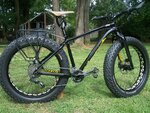My first day here, excited to get to chat with everyone and share experiences and hopefully contribute to the forums.
Since I have 3 fat bikes in my collection I can give some insight perhaps.

The first fat tire bike I purchased 5 years ago, non-e with 4.6" tires. Weighs 32lbs dry and I run the tires from 5-18psi. This is the one bike I keep that is non-e as it is fun on the dirt, in the slop and most of all beach and snow. It is a workout for sure in all cases - that's why I keep it mostly, is to get a workout from it as a form of exercise.
That said, when I invite my hardcore road riding and super fit buddies out to ride on beach and snow, I lend them this bike. A skilled rider who can put out 200-400 watts will have great fun on sand and snow with this bike.
Last year I picked up a Bionx converted KHS 500, one of the few Bionx 170mm rear hubs ever made before they went out of business. It happens to be in my avatar if you want a look at it. Where I love riding this bike is:
-Really rough single track that will just chew up my arms and shoulders on my front suspension/hard tail mountain bike.
-Beach cruising - with the motor on the back I can power through the soft sand a 2.5" or smaller width tire will just sink and fail in, fly along the water's edge floating on the sand (thanks to the 4.8" tires at 12 psi).
-Winter riding. Whole new world for me. All the snowmobile trails near my house are now available to me. I also discovered last year entire 'ski resorts' dedicated to cross country skiers for decades - who allow and fully invite fat bike riders to enjoy their trails (Running at 8 psi).
No longer do I simply 'go indoors' for the winter like years before (and frankly I barely rode, just waiting for spring) - Thanks to fat bikes I'm truly a 4 season rider now.
If you have never tried, riding groomed snow trails in the winter is a bucket list suggestion. I loved it so much I will be purchasing a season pass for the resort this winter.
So yes, as already described above, Fat Bikes are not a good choice if it will be the only bike you ride, if you ride only in the city and never make it to the beach and if you don't want to ride in the winter.
However there are more and more riders like myself who have added a Fat Bike (or 3) to their fleet and value them as the 'right tool' for certain rides we enjoy and most of all truly add winter as the 4th season we often never got to ride outdoors in before.
Cheers

